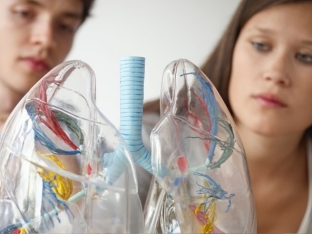Today, medicine knows hundreds of hereditary diseases that can significantly worsen the quality of human life and shorten its duration. One such disease is cystic fibrosis. Cystic fibrosis symptoms can appear at any age. Cystic fibrosis is manifested by damage to certain tissues of the body, & nbsp; dysfunction of the glands of exocrine secretion and disorders of a functional nature. Cystic fibrosis has an autosomal recessive inheritance, the formation of pathology occurs during pregnancy.
What causes the symptoms of cystic fibrosis?
Pathogenetic development of symptoms of cystic fibrosis is based on three main mechanisms - changes in the connective tissue, disturbance of water and electrolyte balance and damage to the external secretion glands. The main cause of the development of cystic fibrosis is a gene mutation, as a result of which the structure and function of the CFTR protein, the transmembrane regulator of cystic fibrosis, is disrupted. This protein is involved in the process of water and electrolyte metabolism of the epithelium, which lines the bronchopulmonary system, liver, gastrointestinal tract, pancreas and organs of the reproductive system.
The mechanism of development of symptoms of cystic fibrosis in the bronchopulmonary system
In the presence of this pathology, the symptoms of cystic fibrosis develop against the background of changes in the physicochemical properties of the secretion of the glands of the exocrine system. Tears, sweat and mucus produced become thick due to the increased content of protein and electrolytes, so the secret practically does not leave the excretory ducts. Fluid is retained in the ducts and cysts form, often in the bronchopulmonary and digestive systems.
Electrolyte disturbances are provoked by high concentrations of sodium, potassium and chlorine. When the mucus stagnates, the glandular tissue atrophies and fibrosis progresses. Secondary infection and the development of a purulent process are possible.
The bronchopulmonary system suffers due to a disturbed process of sputum discharge in case of impaired function of the ciliated epithelium and increased viscosity of mucus. Mucostasis and chronic inflammation develop with the formation of bronchiectasis, which form emphysematous areas of the lung or atelectasis with complete bronchial obstruction, which provokes the development of pathognomonic symptoms of cystic fibrosis.
Symptoms of cystic fibrosis. Features of the pulmonary form of cystic fibrosis
Cystic fibrosis has several forms, depending on the predominance of lesions of certain glands:
- Pulmonary.
- Intestinal.
- Mixed with respiratory and digestive tract lesions.
- Meconium ileus.
- Atypical forms.
This division is conditional, since in all cases the respiratory tract is predominantly affected. Symptoms of cystic fibrosis appear in the first years of a child's life.

Symptoms of cystic fibrosis in the pulmonary form
A child with cystic fibrosis is pale, lethargic, gains little weight, and often suffers from SARS. The disease can be suspected when a child develops a characteristic paroxysmal whooping cough with discharge of mucopurulent sputum. Such a child is prone to repeated and prolonged pneumonia and bronchitis. There is a risk of developing infectious-dependent bronchial asthma.
Such breathing disorders are accompanied by chest deformity, nails look like watch glasses, fingers look like drumsticks. Patients with symptoms of cystic fibrosis have another feature - a specific sour smell of sweat due to the high pH and chlorine content in sweat.
Progression of cystic fibrosis symptoms can have complications. On the part of the respiratory system, such conditions can develop – pulmonary bleeding, pneumothorax, sinusitis, pleurisy, pleural empyema. If the intestinal form of the disease predominates, cirrhosis of the liver develops, diabetes mellitus develops, there are gastric bleeding, rectal prolapse, urolithiasis, pyelonephritis.
Methods of treatment of cystic fibrosis in different forms
Timely diagnosis and treatment significantly improves the prognosis of life. The pulmonary form is differentiated from BA, chronic pneumonia, whooping cough, obstructive bronchitis. The intestinal form is differentiated from celiac disease, intestinal dysbiosis, enteropathy and disaccharosis insufficiency.
Treatment of cystic fibrosis is symptomatic, aimed at improving or restoring respiratory function. In severe forms, surgery is indicated.
In the treatment of the intestinal form, a high-protein diet with restriction of fats and carbohydrates is prescribed. Food should be salted and drink plenty of fluids. Replacement therapy consists of taking enzyme preparations. The effectiveness of treatment for symptoms of cystic fibrosis is assessed by the disappearance of pain, the normalization of stool, the absence of fat in the stool and the normalization of weight. The pulmonary form involves the appointment of mucolytic agents along with physiotherapy and postural drainage. For medical purposes, bronchoscopy is performed.
It is better to exclude the stay of a child with symptoms of cystic fibrosis in educational institutions. The earlier cystic fibrosis is diagnosed and treatment is started, the better the prognosis for life. The average life expectancy for patients with cystic fibrosis is 45 years.







Add a comment